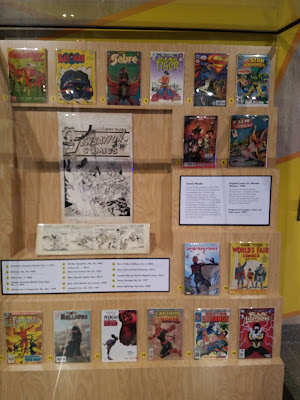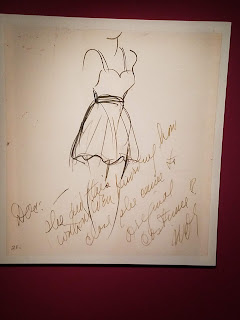
by Bruce Guthrie
I went down to Charlottesville this weekend to see the new Oliphant
exhibit there. While there, I met with Molly Schwartzburg who was
co-curator of the exhibit that I had been sending emails to regarding
photo policies and such. We had a good chat!
This is the official exhibit description:
Oliphant: Unpacking the Archive
September 23, 2019 – May 30, 2020
Celebrating the recent acquisition of editorial cartoonist Patrick Oliphant’s voluminous archive
In
2018, Patrick and Susan Oliphant donated almost 7,000 drawings,
watercolors, prints, sculptures, and sketchbooks to the UVA Library.
Complementing the art is a wealth of archival material: correspondence,
photographs, professional papers, scrapbooks, and recordings. This, the
first exhibition to juxtapose the archive with Oliphant’s artwork, shows
how and why Oliphant became the most widely syndicated, most
influential political cartoonist in America, shaping the political
consciousness of generations.

What happens when a great artist takes
up the profession of political cartooning and deploys all the weapons
in his considerable arsenal to send a message? Endowed with a skepticism
of the status quo, a love of drawing, and little formal training,
Oliphant began his career at eighteen as a copy boy in Adelaide,
Australia. When he joined the Denver Post in 1964 he introduced a linear
fluency and wit—a studied awareness of adversary traditions from
Hogarth, Goya, and Daumier to David Low—as well as an expansive
imagination and conceptual reach as yet unknown to American newspaper
audiences.

Oliphant’s swift rise to prominence, including a Pulitzer
Prize in 1967, was followed by five decades of sustained,
uncompromising work. From Watergate to Bridgegate, from Duoshade to
digital delivery, and from the ephemeral newspaper cartoon to the
lasting medium of bronze, Oliphant’s work both embraces its immediate
context and transcends the particulars of time, place, and medium to
reify universal traits of human character.
Today is a moment of
great change for political commentary and visual satire. As newspapers
continue to fold or merge, and the number of staff editorial cartoonists
drops from hundreds to dozens nationally, Oliphant’s archive will be
essential for understanding the place of political cartoons in
newsprint’s last decades of dominance, and inspiring paths forward in an
era of turbulent uncertainty.
It's a wonderful exhibit, filled with bunches of his daily strips, his sculptures, etc.
For
me, the major disappointment was that most of the artwork were
reproductions. Apparently, the originals were hung for the first couple
of months when it opened in September, but were then rotated out. The
signage was not changed to reflect this so I'm not entirely sure what
was original and what wasn't. That's not the way it's supposed to be in
a research library.
But ignoring that, there is a lot to love about the exhibit:


- The
sketchbooks -- so many sketchbooks! -- are wonderful. There's even one
(clearly a reproduction) that you can pick up and look through. Pat
drew everything!
- There's a huge doodle picture on an easel
that's just amazing. Between classic drawings are phone numbers,
addresses, and appointment reminders.
- The sculptures -- two of
which are downstairs -- are great. The National Portrait Gallery has
copies of most of them too, but they all went off display when the
presidential gallery was reorganized.
- There's a free poster and a
fairly modest brochure. Both
feature a self-portrait that he did for San Diego Comic-Con back in
2009. That was the one that I sat next to his wife Susan during his
talk while he drew obscene things on his writing tablet (Susan kept
covering her eyes during the demo).
- The history lesson about
growing up in Australia and coming here on assignment were interesting.
I always wondered why he was here.
- There was a display about
Punk, the penguin character that visits most of his strips. Punk has
been around.... well, hell, almost forever. It's his signature like
Ralph Steadman's splatter. And like at Steadman's Katzen exhibit,
you'll find Punk on the walls in something like ten places throughout
the building including on floor landings and in the elevator. (Some
Katzen folk got splatters added to their business cards. I'm not sure
that happened with Punk.)
They did a
really nice job and it's well worth the trip. Plus that library also
has an interesting exhibit about the Declaration of Independence and
offset printing.


















































